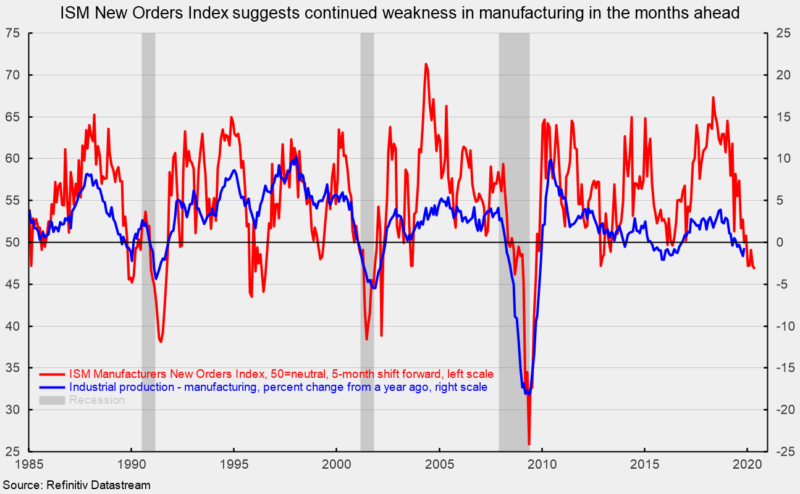ISM Manufacturing Index Remains Below Neutral in December

The Institute for Supply Management’s manufacturing PMI composite index fell to a reading of 47.2 from 48.1 in November. For this index, 50 is neutral, with readings above 50 suggesting expansion and readings below 50 suggesting contraction in manufacturing. Historically, readings above 42.9 have suggested expansion of the overall economy. The December result is the 128th consecutive month above 42.9 but the fifth month below 50, suggesting contraction in manufacturing.
The majority of the sub-indexes were below 50 in December and remained below neutral. Among the key components of the manufacturing index, the production index was 43.2 in December, down from 49.1 in November, suggesting manufacturing output slowed for a fifth month and the pace of decline accelerated. For December, just three industries in the manufacturing survey reported growth while 14 reported contraction.
The manufacturing new-orders index came in at 46.8, down slightly from 47.2 in November and the lowest reading since 2009 (see chart). Three industries reported growth in new orders in December versus 12 industries with declining new orders. Among the top 6 industries, just one reported growth in new orders for the month. Historically, the new orders index has led the Federal Reserve’s manufacturing industrial production index by about five months, suggesting that manufacturing output is likely to decline on a year-over-year basis over the next several months (see chart again).
The new-export-orders index, a separate index that measures only orders for export, was 47.3 in December and has been below 50 for five of the past six months. The average over the last six months is the lowest since July 2009, just after the Great Recession, and is consistent with slowing global economic activity and deteriorating trade relations.
The manufacturing employment index decreased to 45.1 in December from 46.6 in November. The reading suggests manufacturing employment likely decreased in December. The Bureau of Labor Statistics will be releasing its own employment report for December on Friday, January 10. Consensus estimates are for a 160,000 increase in total nonfarm jobs for the month.
The supplier deliveries index, a measure of delivery times for suppliers to manufacturers, came in at 54.6, up from 52.0 in November. It suggests suppliers are falling further behind in delivering supplies to manufacturers with the slippage accelerating a bit from the prior month.
Backlogs of orders, inventories, customers’ inventories, and imports all showed readings below the neutral 50 level in December, with backlogs at 43.3, inventories at 46.5, customers’ inventories at 41.1 and imports at 48.8.
The prices index did post an increase for the month, rising to 51.7 from 46.7 in November. However, the barely-above-neutral result is still a weak reading by historical comparison and suggests price pressures remain modest.
Today’s report from the Institute of Supply Management suggests that weakness in the manufacturing sector continued in December and the outlook remains unfavorable. Comments from the survey participants suggest business confidence is softening. Furthermore, global trade remains a significant issue for many manufacturers and sentiment overall remains cautious regarding growth prospects in the short term.





